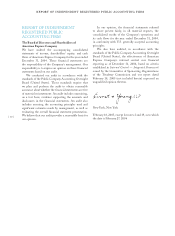American Express 2006 Annual Report Download - page 80
Download and view the complete annual report
Please find page 80 of the 2006 American Express annual report below. You can navigate through the pages in the report by either clicking on the pages listed below, or by using the keyword search tool below to find specific information within the annual report. [ 78 ]
notes to consolidated fi nancial statements
american express company
Investments
Investments include debt and equity securities and are
classified within both the available-for-sale and trading
categories.
Available-for-sale investment securities are carried
at fair value on the Consolidated Balance Sheets with
unrealized gains (losses) recorded in accumulated
other comprehensive (loss) income, net of income tax
provisions (benefits). Gains and losses are recognized in
results of operations upon disposition of the securities.
Gains and losses on these investments are recognized
using the specific identification method on a trade date
basis. In addition, realized losses are recognized when
management determines that a decline in value is other-
than-temporary, which requires judgment regarding
the amount and timing of recovery. Indicators of other-
than-temporary impairment for debt securities include
issuer downgrade, default, or bankruptcy. The Company
also considers the extent to which cost exceeds fair value,
the duration and size of that gap, and management’s
judgment about the issuer’s current and prospective
financial condition.
Trading investment securities are carried at fair value
on the Consolidated Balance Sheets, and changes are
recorded in results of operations.
The Company uses quoted market prices to determine
fair value. If quoted market prices are not available, the
Company estimates fair value using prices of similar
assets or the present value of estimated expected future
cash flows when similar assets do not exist.
Loans
Cardmember lending
Cardmember loans represent amounts due from lending
product customers. These loans are recorded at the time
a cardmember enters into a point-of-sale transaction
with a merchant or when a charge card customer enters
into an extended payment arrangement. Cardmember
loans are presented on the Consolidated Balance Sheets
net of reserves for cardmember losses, discussed below,
and include accrued interest receivable and fees as of
the balance sheet date. Cardmember loans also include
balances with extended payment terms on certain charge
card products. The Company’s policy is to cease accruing
for interest receivable once a cardmember loan is more
than 180 days past due.
Reserve for losses — cardmember lending
The Company’s methodology for reserving for losses
relating to cardmember loans is consistent with reserving
for losses relating to cardmember receivables, with the
exception that cardmember loan balances are written off
when 180 days past due.
International banking
International banking loans include amounts due from
consumers, high net worth individuals, banks and
other institutions, and corporations. Consumer and
private banking loans include unsecured lines of credit,
installment loans, mortgage loans, and auto loans to
retail customers as well as secured lending to high net
worth individuals. Loans to banks and other institutions
represent trade-related financing and other extensions
of credit. Corporate loans represent commercial and
industrial loans as well as mortgage and real estate loans
to corporate customers. International banking loans
are stated at the principal amount outstanding net of
unearned income and are presented on the Consolidated
Balance Sheets net of reserves for losses, which are
discussed below.
Reserve for losses — international banking
For smaller-balance consumer loans, management
establishes reserves for losses inherent in the portfolio.
Generally, these loans are written off in full when an
impairment is determined based upon bankruptcy or
other customer specific circumstances, or when the loan
becomes 120 or 180 days past due, depending on loan
type. Loans, other than smaller-balance consumer loans,
are placed on nonperforming status and considered
impaired when payments of principal or interest are
90 days past due or if, in management’s opinion, it is
probable that the Company will be unable to collect
all amounts due according to the contractual terms of
the loan agreement. Any interest accrued on impaired
loans is reversed and charged against current earnings,
and interest is thereafter included in earnings only to the
extent actually received in cash. When there is doubt
regarding the ultimate collectibility of principal, all cash
receipts are thereafter applied to reduce the recorded
investment in the impaired loan. In such cases, amounts
received after the recorded investment in the impaired
loan has been completely drawn down are recognized
as interest income. The allowance for impaired loans is
measured as the excess of the loan’s recorded investment
over either the present value of expected principal and
interest payments discounted at the loan’s effective
interest rate or, if more practical for collateral-dependent
loans, the fair value of collateral. For floating rate
impaired loans, the effective interest rate is fixed at the
























